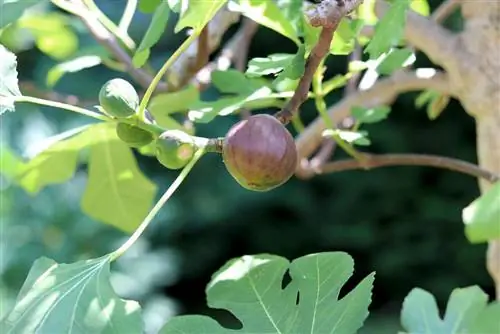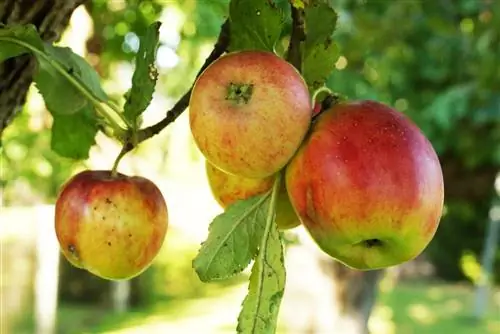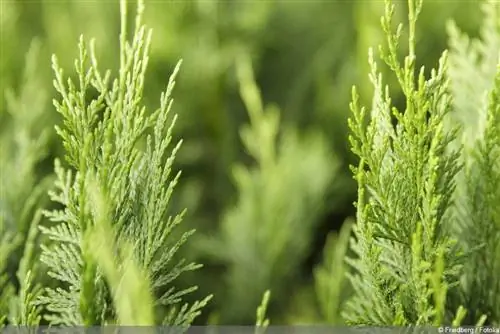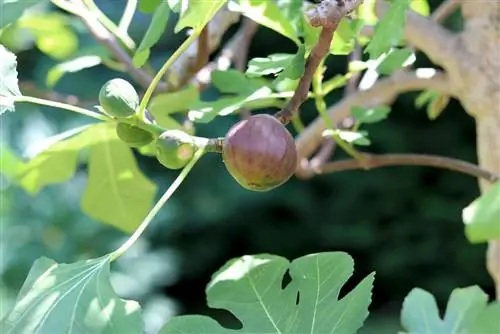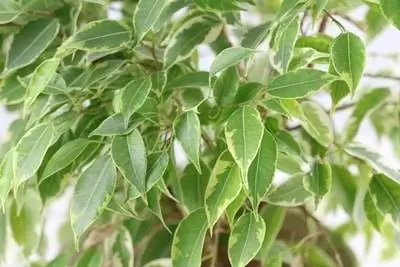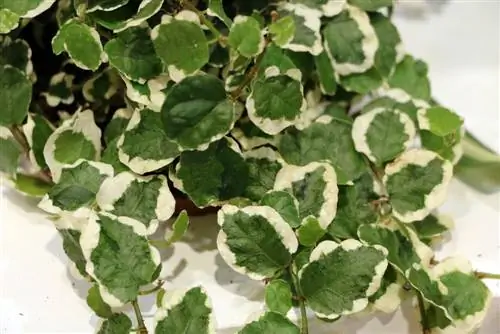- Author admin [email protected].
- Public 2023-12-17 03:39.
- Last modified 2025-06-01 06:48.
The real fig (Ficus carica) is a popular potted plant that bears plenty of fruit if well cared for. In their countries of origin, the plants often reached impressive sizes of up to six meters. Although figs can also be cultivated in regions with winter periods, their growth remains stocky. They usually have to be kept frost-free over the winter, but there are now varieties that are partially hardy.
Profile
- Plant family: Mulberry family
- Flowering period: March-June
- Lifespan: up to 90 years
- Poisonous in all parts except for the fruit
- conditionally hardy - depending on the variety
- separate-sex plants
- complex pollination ecology
Location
The fig needs a protected and full sun location. This not only protects it from frost, but the fruits also develop optimal sweetness. Although there are varieties such as “Paradiso” or “Violetta” that, according to the manufacturer, can withstand temperatures down to -20°C, these trees still need to be protected from frost for the first ten years. Although they will not usually die off straight away in forestry, the damage to the shoots is often so great that they will not bloom in these years and sometimes in the following years.
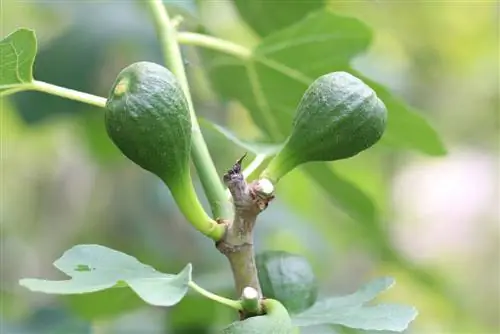
Although the trees like it very warm, they appreciate it when the ground around them is shaded. If the tree is planted outdoors, ground cover can be used. Protecting the root ball from too much sun is particularly important when growing in pots, as the roots can be damaged if there is too much heat.
Flowering time
Flowering often varies depending on the variety and the surrounding climate. In very warm and mild regions, the trees can even bloom and bear fruit up to three times a year. As a rule, however, in temperate regions the period in which the trees can ripen fruit is only sufficient for a single harvest.
Tip:
If the tree is planted in a frost-free winter garden, then the owners can enjoy a constant and bountiful harvest.
Floor
The advantage of the fig is that it does not place any above-average demands on the soil. The bottom should be like this:
- nutrient-rich
- profound
- easy
Waterlogging should be avoided in any case. If the soil is too compacted, it can be loosened with a mixture of sand and clay granules, for example. However, gravel should be avoided as the fig does not particularly like lime.
pot culture
When growing in pots, special care must be taken to ensure that no waterlogging occurs. When it comes to the composition of the substrate, a mixture of garden soil and compost soil is completely sufficient for the fig tree. The pot should be large enough for the plants, but not too large. If the pot is too large, the plant will concentrate too much on root growth and produce only moderate fruit.
When choosing a planter, you should pay attention to high stability. The Ficus carica has very large leaves and therefore offers a good surface for the wind to attack. So that the trees in the pot cannot be blown over so easily, a rather heavy pot made of clay or concrete should be chosen.
Tip:
To make moving into winter quarters easier, you can choose a bucket on wheels.
Planting time
When growing in a pot, it is not relevant when the fig is planted. However, if it is a variety that goes outdoors, it should not be planted before mid-May. By this point, the plant can become accustomed to the climate during the day. However, you should only plant out when there are no more frosts.
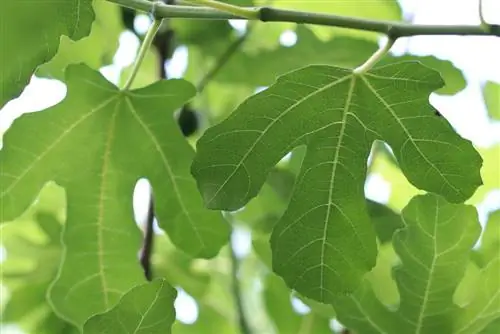
It is also possible to plant plants that have been overwintered indoors frost-free outdoors during the summer. However, the effort involved in repotting is very high and is only advisable for very small plants. In large plants, the root network is often damaged too much, which means that the fruits also fail.
Pouring
Although the common fig prefers a warm climate, it still likes consistently moist soil. Rainwater is ideal for watering. What figs don't like is lime, not just in the soil, but also in the form of irrigation water. Long-term hard water can even cause plants to die. A regular supply of water is essential, especially when the first flowers appear. If there are dry periods, the plant sheds flowers and unripe fruits to protect itself. Therefore, the substrate should always be constantly moist.
Waterlogging should also be avoided. When growing in a pot, a drainage layer made of clay granules, for example, can be created as the bottom layer for safety. If the site is located outdoors, the soil must be optimally prepared beforehand. It is enough to loosen the soil thoroughly and add enough sand to it.
Fertilize
Figs need sufficient nutrients for good development, but too rich a substrate can cause the trees to grow tall and forget to produce flowers. The first fertilizer application of the year can be made in early spring. A long-term fertilizer such as horn shavings or a solid fertilizer pressed into pellets is ideal. This covers the basic needs of the tree.
From the beginning of the flowering period, the tree must be supplied with additional nutrients. A liquid fertilizer that can be absorbed quickly is ideal for this. There are commercially available fertilizers suitable for potted plants, but they are not always suitable for plants whose fruits are eaten. Alternatively, you can make your own plant fertilizer.
Suitable for this are:
- Stinging nettle manure
- animal manure (e.g. from the farmer)
- animal dung dissolved in water
The nettle manure not only promotes growth, it also generally strengthens the plant, making it less susceptible to diseases and pests
Cutting
Because the trees can bloom three times a year, they are very insensitive when it comes to cutting time. However, pruning in spring is ideal as this also promotes growth and flowers. As a rule, the trees have a rather stocky growth due to the climatic conditions, which means that large pruning is rarely necessary.
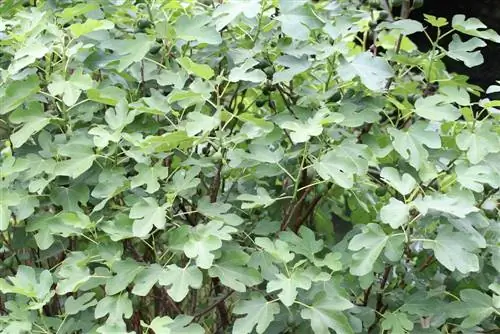
When pruning, make sure that the individual side branches are free and can be easily lit by the sun. A light tree not only produces more fruit, they also develop a more intense sweetness if they are well illuminated by the sun.
Cutting instructions:
- remove obstructing shoots
- light bush/crown interior
- if new growth is desired, leave branch stubs standing
- remove old shoots
- Radical cut only if there is a risk of aging
Wintering
If the plant is overwintered outdoors, it must be wrapped up well in autumn at the latest. Bamboo mats in combination with several layers of fleece are ideal for this. There are now also bubble wraps commercially available for wrapping frost-sensitive plants. However, care should be taken to ensure that the tree receives enough air so that moisture can escape. Otherwise, constantly moist areas on the bark will weaken it, making the tree more susceptible to pests and diseases.
Tip:
The fig is overwintered in a pot in a bright location. Watering is only moderate during the winter months, unless you want the flowers and fruits to continue to form in the winter garden.
Diseases and pests
The advantage of the real fig is that it is hardly attacked by pests. Occasionally, ants discover very overripe fruits, which disappear after harvesting. The fig tree is somewhat more susceptible to diseases. The following diseases can be dangerous to plants and lead to crop failure:
- Rust fungus
- Fig mosaic virus
- Root rot
However, these problems usually only occur when there are errors in care. In this case, nettle manure can be used again, which strengthens the leaf structure. If there is an infestation by fungi, a mixture of water and milk (1:1) can also be used. The affected areas are sprayed generously.
Propagation
Theoretically it is possible to propagate the fig from seeds. If you look inside the fruit you can see countless small seeds. The problem with the real fig, however, is that there are male and female plants. Although the female plants that later form the fig fruits do not necessarily need a male partner for pollination, if they are propagated via seeds there is a risk that male plants will grow.

To ensure that only female plants are propagated, propagation from cuttings is preferred. To do this, cuttings are separated from the mother plant and planted at least two eyes deep into the soil. It usually takes a few months for the cuttings to take root. Therefore, growing cuttings in pots is better than outdoors.
Care tips for beautiful growth
- by watering urgently in spring, watering moderately in autumn
- drain excess water
- Provide the plants with liquid fertilizer every week from April to September
- unripe fruits can remain on the tree in autumn

